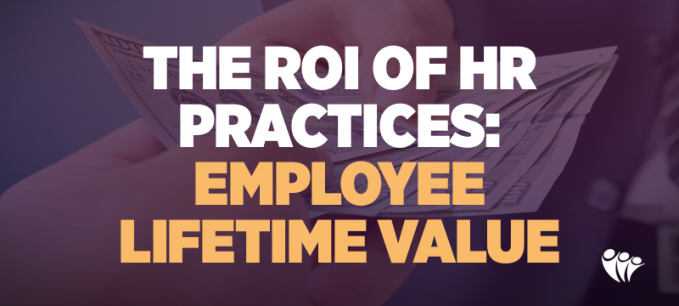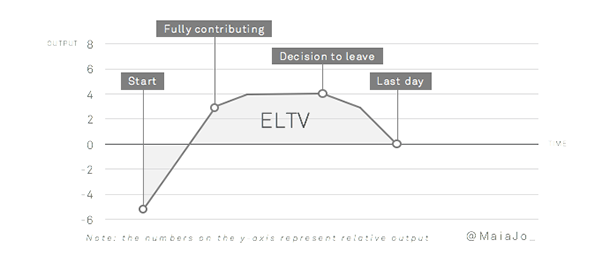The ROI of HR Practices: Employee Lifetime Value

Several decades ago, management guru Tom Peters spoke about the customer as an “appreciating asset.” While a customer might only purchase $100 worth of groceries a week, over 10 years that adds up to a “portfolio” worth roughly $50,000.
If a restaurant hires an incompetent, ill-mannered waiter, and we assume the waiter handles five tables a night over a series of weeks, the waiter may have just lost a set of portfolios cumulatively worth $300,000 or more before being let go. Pretty significant damage. And that doesn’t account for the “ripple effect" cost of unsatisfied customers who might badmouth the restaurant to their friends and write negative reviews online. Untold damage in a networked world.
The point Peters made was that when you start thinking about business in this way, you will start to reevaluate the way you hire, train, equip, compensate, and manage your staff.
“Whenever I see a new customer walk through the door, I see $10,000 burnt into their forehead.”
— Tom Monaghan, founder of Domino’s Pizza
Today, this type of discussion is commonly linked to the marketing concept known as Customer Lifetime Value (CLTV).
Like the idea of the customer as an appreciating asset, there is another important “asset” that appreciates in value over time: the employee. (You may already guess where this is going.)
Enter Employee Lifetime Value (ELTV).
ELTV can be defined as “a quantitative measure of the long-term contribution an employee makes to an organisation” or “the total net value over time that an employee brings to an organisation.”
If we accept the premise that most of a company’s assets are linked to the intangible capital residing within humans (85% according to the Brookings Institute), we should be interested in attempting to approximate, if not wholly isolate, the relative contribution of an employee during their tenure with an organisation. While organisations often pay lip service to the importance of their employees, attempts to measure employee value have often been ignored by the business community, and, in the absence of prominent models on employee value to point to, many organisations still continue to view employees through a cost/expense dominant lens.
One model that has been proposed, which can be viewed as a generic model of ELTV capable of being applied, with modifications, to a variety of business situations, follows:

Source: The Forum for People Performance Management and Measurement
Adding to this picture, Maia Josebachvili presents a series of simplified but extremely useful graphics on ELTV (one of which is included below). The job of the people team or HR is to maximise ELTV, or the shaded area above the line, making this area as long and as tall as possible through quality hiring, onboarding, development, and management practices.

Source: Maia Josebachvili
“One subpar employee can throw an entire department into disarray. Team members end up investing their own time into training someone who has no future with the company.”
— Ryan Holmes, CEO of HootSuite
The Full Impact of a Hire
If we assume a salesperson quits his job within the first month of being hired, I think we could agree that the company has just suffered a net loss. Recruiting/onboarding activities would likely outweigh the revenue the salesperson would’ve generated in this short time. In the graph above, you could show this by subtracting the grey area below the line from whatever has been produced above the line to show a net dollar value. This is fairly easy to do with a salesperson whose main form of contribution is revenue. However, the total impact that an employee has on the business goes beyond a simple subtraction from output/cost. In that time, the salesperson — if we assume he was a bad apple — could have seriously damaged customer relationships, manager productivity, and team morale. Conversely, if the salesperson was a good hire, and we assume he simply departed due to mismanagement, we could also talk about the lost productivity, customer goodwill, and training investment that the competition might profit from. Beyond revenue or productivity outputs, there are additional factors that should be considered when appreciating the total impact of an employee.
8 Impact Points
- Output / Productivity - Usually the main reason why someone is hired. For departments like sales and marketing, this revolves around revenue added (the easiest value to quantify); for support functions like finance, administration, and HR, their output would revolve more around value added/costs reduced (not always easy to quantify).
- Team Impact - The presence of a bad hire can cripple the entire productivity of the team due to incompetence and/or a negative attitude, causing others to disengage and — if the environment becomes toxic enough — leave. Conversely, the introduction of a good hire can take a team to new heights of performance. A 2010 Hudson study found that the negative impact on teamwork and engagement was the #1 concern employers had about the consequence of a bad hire (51%), ahead of loss of productivity (34%), and impact on customer service (18%).
- Manager Impact - A manager who is burdened with a bad hire must dedicate extra time and resources to overseeing his/her work. It is now generally accepted that a team’s direct manager has the single greatest impact on their performance, so it’s of the utmost importance that the new hire does not have an adverse impact on this key individual.
- Cultural Impact - In a world where systems, technology, and processes can largely be copied, much has been written about the competitive advantage of culture to attract, engage, and retain top talent. Each and every hire impacts more than just their immediate team and manager — they affect the broader ecosystem. Like the famed wing flaps of the butterfly that caused a hurricane (see chaos theory), the actions of a single individual can have imperceptibly small yet far reaching consequences.
- Customer Impact - As discussed above, this is the $10,000+ kind of damage that a bad hire can do from a single customer interaction. Conversely, a good hire can be the reason that customers choose to do business with you over your competitors. Even in the most transactional retail environments, such as your local coffee shop, the personality of the barista can mean the difference between becoming a lifetime customer and spending hundreds of dollars every year and talking to all your friends about why you avoid the shop like the plague.
- Brand Impact - When a customer has an experience with an employee and he/she chooses to share that experience with others, this can strengthen or weaken the brand’s reputation—causing customers and top talent to draw closer or keep their distance.
- Deep Company Know-How (Crucial Tacit Knowledge) - The longer employees stay with your company, the deeper the understanding of the business, its structure, political dynamics, and the ways of working that aren’t explicitly stated in the company operations manual. A top hire can be a huge loss to your company, particularly if they go to one of your competitors, taking with them not only the relationship goodwill built with customers, but also crucial tacit knowledge of company processes and systems that took years to accumulate.
- Leadership Potential - The longer employees stay with your company, the greater their capacity to impact others. These individuals may rise to hold formal leadership positions (e.g., business unit manager or C-suite level) or take on informal leadership roles (e.g., coaching peers and mentoring juniors). Over time, individuals who grow in leadership skills can turn out to be one of the company’s most valuable investments.
Appreciating the Asset
You may find the idea of being asked to see every human being you encounter in business with a dollar figure “stamped” on their forehead or as a series of value points on a chart to be “maximised” as, understandably, a bit questionable. However, I believe these kinds of models have their place when considered in context and as one part of a much broader conversation on people management. As the logical extension to CLTV, an established business term, ELTV can serve as a model, reference point, and shared language to understand, articulate, discuss, and justify HR practices within any organisation.
For more on using ELTV to quantify the ROI of HR practices, I highly recommend Maia’s article.
Topics:
Human Resources
Theo Winter
Client Services Manager, Writer & Researcher. Theo is one of the youngest professionals in the world to earn an accreditation in TTI Success Insight's suite of psychometric assessments. For more than a decade, he worked with hundreds of HR, L&D and OD professionals and consultants to improve engagement, performance and emotional intelligence of leaders and their teams. He authored the book "40 Must-Know Business Models for People Leaders."

/From%20Daily%20Tasks%20to%20Strategic%20Impact%20Empowering%20Frontline%20Team%20Members%20to%20Work%20On%20Their%20Job.png?width=374&name=From%20Daily%20Tasks%20to%20Strategic%20Impact%20Empowering%20Frontline%20Team%20Members%20to%20Work%20On%20Their%20Job.png)

We Would Like to Hear From You (0 Comments)